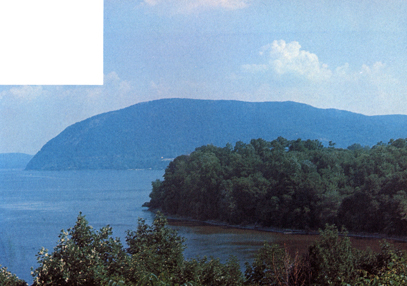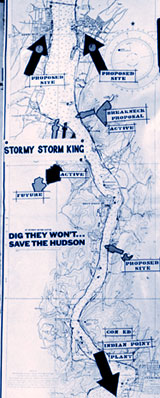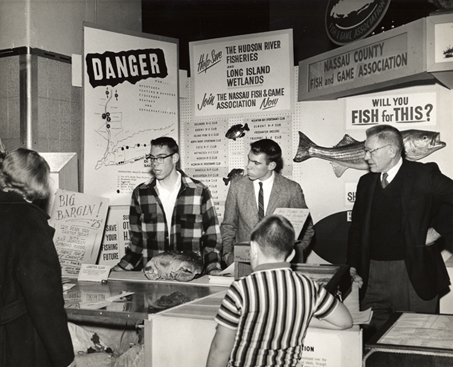The Scenic Hudson Decision

The Scenic Hudson Decision was a 17-year (1963-1981) legal dispute which defeated Consolidated Edison's plan to embed the world's largest pumped storage hydroelectric plant into the face of Storm King Mountain, near Cornwall, New York. The lengthy and controversial case had an immense impact on environmental and legal issues affecting the Hudson River Valley as well as the nation. The landmark case set important precedents in environmental law including: the right of citizens to participate in environmental disputes, the emergence of environmental law as a legal specialty, ideas Congress incorporated in the country's first National Environment Policy Act (NEPA), federal and state regulation of the environment, and it is credited with launching the modern environmental movement.

In September 1962, the Consolidated Edison Company announced plans to build a pumped storage facility, the largest of its kind in the world, at Storm King Mountain near Cornwall, New York. The initial application for license to construct the plant was filed with the Federal Power Commission in January 1963. On November 8, 1963, a small group of concerned citizens met at the home of Carl Carmer and formed the Scenic Hudson Preservation Conference to fight the pumped storage project on the grounds that it posed a threat to the Cornwall water supply, the Hudson River fisheries, and to the scenic beauty and historic significance of Storm King Mountain.
Storm King Mountain lies along the west bank of the Hudson River just south of Cornwall. The name Storm King was coined by 19th century writer Nathaniel Parker Willis. Noting that the mountain was the tallest in the region and an accurate predictor of stormy weather when early morning clouds covered its peak, he felt there could be no better name than Storm King. This name would prove true as the mountain range found itself involved in the most contentious environmental legal case our nation has seen. Thanks to the tireless work of those involved with Scenic Hudson the mountain would come to weather this storm as well. Today the mountain is home to Storm King State Park and thousands of visitors come to hike the trails this historic mountain has to offer.

Carl Carmer, author of The Hudson River and other historic works, became honorary chairman of Scenic Hudson, Inc. and Leo O. Rothschild was named chairman. Rothschild served until 1968 and was succeeded by Alexander Saunders. Initially, the members, working in their own homes or borrowed office space, contacted friends, prominent citizens, politicians, and other organizations for financial support, letter writing campaigns, and legal intervention. The organization grew rapidly. Contributions were channeled through the Natural Area Council until Scenic Hudson was incorporated in 1974. Rod Vandivert became the executive director in the mid-1960s. An office was set up in New York City, but the location changed several times during the Storm King case and there were a number of office managers during that period. Professional fundraisers and public relations firms were employed in later years.
Aided by other organizations and individuals, the group conducted an intensive campaign to educate the public and to deter Consolidated Edison by legal means. The records, which document the organization's activities, include publicity materials, copies of legal documents submitted by Scenic Hudson and others, and transcripts of hearings before Congressional sub-committees and the Federal Power Commission. The case lasted for 17 years. In a negotiated settlement in December 1980, Consolidated Edison agreed to drop the plan for the Storm King facility.

The Scenic Hudson Decision: Timeline
- 1963 (January) – Consolidated Edison applied to the Federal Power Commission for a license to build the Storm King Project. The proposed project would have had a capacity of 2,000,000 kilowatts and included a power house 800 feet long at the base of Storm King Mountain, an upper reservoir behind Storm King nearly one mile across, and fifteen miles of transmission lines across Putnam County and, as originally planned, Westchester County .
- 1963 (November) – Scenic Hudson Preservation Conference was formed and petitioned to intervene in the Federal Power Commission hearings. The towns of Philipstown, Putnam Valley, Cortland and Yorktown intervened later.
- 1964 (February) – Initial hearings were held before a Federal Power Commission Hearing Examiner. Further hearings were held in May and June.
- 1964 (November) – Joint State Legislative Commission on Natural Resources held hearings at Bear Mountain and later issued a report effectively opposing the Storm King project.
- 1964 (March) – The Federal Power Commission granted a license for Storm King, rejecting the petitions from the Hudson River Fishermen's association, among others, to reopen hearings to consider new generating alternatives and newly disclosed dangers to fish life. (33 FPC 428 (1965)).
- 1965 (July) – Scenic Hudson and the towns petitioned for review to the U.S. Court of Appeals for the Second Circuit.
- 1965 (December 29) – The Court of Appeals set aside the Storm King license and remanded to the Federal Power Commission in a decision marking the birth of environmental law. The court stated that “The Commission's renewed proceedings must include as a basic concern the preservation of natural beauty and national historic sites, keeping in mind that in our affluent society, the cost of a project is only one of several factors to be considered.” In addition, the court ruled that “On remand, the Commission should take the whole fisheries question into consideration before deciding whether the Storm King Project is to be licensed.” Scenic Hudson Preservation Conference v. Federal Power Commission, 354 F. 2d 608 (2d Cir. 1965), cert. denied. Sub nom. Consolidated Edison v. Hudson River Preservation Conference, 384 U.S. 941 (1966).
- 1966 (January) – Governor Rockefeller appointed Hudson River Valley Commission stating “…scenic values are paramount [at Storm King] and the plant should not be built if a feasible alternative can be found…”
- 1966 (May) – Consolidated Edison amended its license application to place the powerhouse underground.
- 1966 (July) – The Hudson River Fisherman's Association and others intervened in the remanded case.
- 1966 (October) – The U.S. Department of Interior recommended that the project “not be built”.
- 1966 (November) – Remanded hearings began.
- 1967 (May) – Remanded hearings ended.
- 1968 (August 6, 1968) – Federal Power Commission Hearing Officer recommended that license be granted.
- 1968 (October 25, 1968) – City of New York moved to intervene and reopen case, alleging dangers to Catskill Aqueduct. The new power plant would be blasted out of stone 140 feet away from the main pipe of the Aqueduct, at a point where it had broken years earlier.
- 1968 (November 19) – Federal Power Commission reopened case to consider the City's concern. Consolidated Edison proposed an alternate location in the Palisades Interstate Park. The Park Commission intervened in opposition. (40 FPC 1310 (1968)).
- 1969 (March) – Renewed Federal Power Commission hearings on Aqueduct and Palisades Park alternative began.
- 1969 (May) – Renewed hearings ended.
- 1969 (December 23, 1969) – Presiding Examiner issued a supplemental initial decision concluding that the Cornwall site presented no hazard to the aqueduct and that the alternative site was not profitable. (44 FPC 350 (1970)).
- 1970 (August 19) – The Federal Power Commission re-licensed Storm King.
- 1971 (January) – Scenic Hudson, the Hudson River Fisherman's Association, The City of New York, the Palisades Park Commission and others appealed the Federal Power Commission decision.
- 1971 (September) – The New York State Department of Environmental Conservation granted water quality certification for the project.
- 1971 (October) – The Court of Appeals in a two-to-one vote, upheld the Federal Power Commission license. The court later split four-to-four on reconsideration. (453 F. 2d 463 (2d Cir. 1971), cert. denied 407 U.S. 926 (1972)).
- 1972 (March) – The New York State Supreme Court, Albany County, set the Department of Environmental Conservation's water certification aside. (Mtr. Of deRham v. Diamond, 69 Misc. 2d 1 (1972)).
- 1972 (June) – N.Y.S. Appellate Division reinstated water quality certification. (Mtr. Of deRham v. Diamond, 39 A.D.2d 302 (3d Dep't 1972 )).
- 1973 (February) – Scenic Hudson and the Hudson River Fisherman's Association petitioned the Federal Power Commission to reconsider the Storm King license and hold further hearings alleging, among other things, an erroneous fisheries study which was relied upon in granting the 1970 license. The study had failed to treat the Hudson River as tidal and had thus allegedly understated the plant's impact upon striped bass by as much as ten times.
- 1973 (March) – N.Y.S. Court of Appeals upheld water quality certification granted by the Department of Environmental Conservation. (Mtr. Of deRham v. Diamond, 32 N.Y.2d 34, 343 N.Y.S. 2d 84, 295 N.E.2d 763 (1973)).
- 1973 (May 31) – The Federal Power Commission rejected the Scenic Hudson and Hudson River Fisherman's Association Petitions. (49 FPC 1227 (1973)).
- 1973 (May) – Scenic Hudson and Hudson River Fisherman's Association again petitioned for review to the U.S. Court of Appeals for the Second Circuit.
- 1973 (December) – In a parallel lawsuit brought by Scenic Hudson and Hudson River Fisherman's Association, the federal district court enjoined Consolidated Edison from dumping rock excavated from the project site into the Hudson River, until a Corps of Engineers permit was obtained. Scenic Hudson Preservation Conference v. Callaway, 370 F. Supp. 162 (S.D.N.Y. 1973), aff'd 499 f.2d 127 (2d Cir. 1974).
- 1974 (March) – Consolidated Edison began construction of project on a limited basis.
- 1974 (May 8) – Court of Appeals granted Hudson River Fisherman's Association petition and ordered further hearings on the fisheries issue. Hudson River Fisherman's Ass'n v. Federal Power Comm'n,. 498 F.2d 827 (2d Cir. 1974), rehearing denied (July 1, 1974).
- 1974 (July 30) – New Federal Power Commission hearings on fisheries began. Plant construction was halted. N.Y.S. Attorney General joined as active participant in opposition. (52 FPC 238 (1974)).
- 1974 (December 11) – Fisheries hearings ended, largely incomplete. Shortly afterwards, Consolidated Edison petitioned Federal Power Commission for an extension in the construction schedule to undertake further fisheries studies. (52 FPC 1761).
- 1975 (May) – N.Y.S. Attorney General's lawsuit required New York State Public Service Commission to consider prudency of Storm King continuation.
- 1975 (June 26) – Public Service Commission directed Consolidated Edison to file report justifying Storm King project. (15 NYPSC 1031 (1975)).
- 1975 (August 8) – The Court of Appeals authorized further fisheries studies and enjoined Storm King project pending Federal Power Commission resolution. (73 Civ. 2258).
- 1976 (March) – Consolidated Edison report to public Service Commission urged construction of Storm King, but acknowledged that some alternatives are not more costly.
- 1976 (September) – Scenic Hudson and Hudson River Fisherman's Association petitioned the Federal Power Commission to reopen hearings on the Storm King license on grounds of economics, environment and changed circumstances. City and Attorney General joined in support, as did staff of Federal Power Commission.
- 1976 (December 22) – Federal Power Commission denied petitions without prejudice to renewal, and extended time for completion of fisheries studies. (56 FPC 3705).
- 1977 (Spring) – Environmental Protection Agency fisheries hearing on existing Hudson River power plants (Indian Point, Bowline, Roseton) began. Federal Power Commission hearings were deferred pending resolution of EPA cases.
- 1978 (December) – Scenic Hudson and Hudson River Fisherman's Association again petitioned Federal Power Commission (now called Federal Energy Regulatory Commission) to terminate the Storm King license because of change of circumstances. The New York State Public Service Commission joined in the request, as did the Attorney General, State Department of Environmental Conservation and the Department of Interior.
- 1980 (December 20) – Scenic Hudson and Consolidated Edison reached a settlement in which Consolidated Edison agreed to terminate its plans for Storm King Mountain, reduce fish kills at Indian Point and other power plants along the Hudson River, and establish a research fund for the Hudson River ecosystem in return for not having to install closed-cycle cooling towers at existing plants.
- 1981 (July 23) – The Federal Energy Regulatory Commission approved Consolidated Edison's surrender of the Storm King license pursuant to the Settlement Agreement.
Marist University | Marist Archives & Special Collections | Contact Us |Acknowledgements